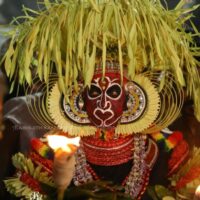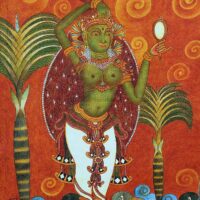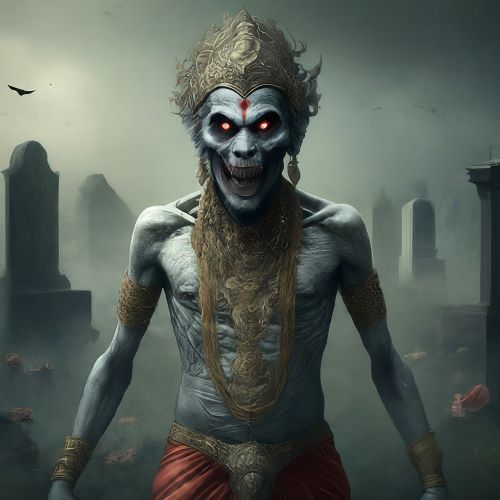Yakshi : The Seductive Vampire
Listen
At a glance
| Description | |
|---|---|
| Origin | Indian Mythology |
| Classification | Spirits |
| Family Members | N/A |
| Region | India |
| Associated With | Seduction, Blood sucking |
Yakshi
Introduction
The Yakshi is one of the most enduring figures in Kerala’s folklore, embodying a mix of beauty, mystery, and terror. Originating from pan-Indian traditions where Yakshis were linked to fertility and prosperity, she took on a darker form in Kerala’s cultural imagination over the centuries. Unlike benevolent nature spirits, the Yakshi of Kerala became a spectral seductress who haunts lonely pathways, village groves, and the fragrant Paala tree. She is remembered as both a spirit of vengeance and a warning about desire and betrayal. Far from fading into obscurity, the Yakshi remains alive in regional stories, religious practices, art, cinema, and even contemporary reinterpretations, making her one of Kerala’s most fascinating cultural icons.
Physical Traits
The Yakshi is almost always described as extraordinarily beautiful. She appears as a young woman with long black hair, jasmine garlands, and traditional ornaments, often dressed in flowing attire that enhances her charm. Her enchanting smile and radiant skin captivate those who encounter her. But beneath this captivating exterior lies her true form. When she reveals herself, she becomes a terrifying figure with blood-red eyes, protruding fangs, claw-like nails, and a thirst for human blood.
A unique aspect of Yakshi folklore is the detail that her feet face backward or that her back is hollow, betraying her supernatural nature. The sickly-sweet scent of Paala (Alstonia scholaris) flowers is often said to precede her appearance, making the tree inseparable from her myth. Beyond oral tales, modern Kerala has also immortalized the Yakshi through art, most famously in the 30-foot concrete sculpture at Malampuzha by artist Kanayi Kunhiraman. Completed in 1969, the statue, with its bold nudity and commanding presence, sparked debate but remains one of Kerala’s most recognized depictions of the Yakshi.
Family
Unlike many mythological beings tied to divine families, the Yakshi in Kerala folklore is often seen as the spirit of a wronged woman whose tragic or violent death transformed her into a supernatural force. This interpretation reflects the strong connection between human suffering and the creation of restless spirits in Kerala’s storytelling tradition.
One of the most famous legends is that of Kanjirottu Yakshi, also known as Chiruthevi. Once a courtesan in Travancore, she was betrayed by her lover and brutally killed, only to return as a Yakshi who terrorized men with her vengeful beauty. Eventually, her fury was subdued when she was ritually installed in a temple, transforming her into a protective deity associated with Lord Narasimha.
Another powerful figure is Kalliyankattu Neeli, remembered for her terrifying powers and tragic past. Wronged in life and reborn as a Yakshi, she became so feared that only the legendary priest Kadamattathu Kathanar could control her through spiritual means. These stories reveal how Yakshis symbolize both the pain of betrayal and the redemptive potential of ritual, allowing a feared spirit to evolve into an object of worship.
Other names
While “Yakshi” is the most common term, variations appear in literature and local traditions. In Prakrit texts, she was called Yakki, while Tamil sources used Isakki, a name that survives in South Indian folk worship. Early Buddhist and Jain texts mention her as Yakkhini, often benevolent and tied to fertility. In Kerala, specific Yakshis bear individual names, such as Chiruthevi (the human identity of Kanjirottu Yakshi) or Neeliamma, a reverential title given to Kalliyankattu Neeli. In villages where Yakshis are worshipped as deities, she may also be referred to as Yakshiamma, symbolizing her transition from feared spirit to protective mother figure.
Powers and Abilities
The Yakshi is remembered above all for her shape-shifting abilities. She often appears as a dazzlingly beautiful woman who lures unsuspecting men traveling at night. Once alone with her victims, she drops the illusion and reveals her monstrous form, sinking her fangs into them to drain their blood or life force. Her association with the Paala tree reinforces her link with liminal spaces where the human and spirit worlds meet.
Legends also credit her with extraordinary speed, the ability to appear and vanish at will, and hypnotic powers that cloud the judgment of her prey. Beyond her role as a predator, the Yakshi is also connected to themes of justice and vengeance, often targeting those who wrong women. At times, she undergoes a transformation through ritual, becoming a guardian deity rather than a demon. This fluidity reflects Kerala’s broader spiritual tradition, where even fearsome beings can be pacified and integrated into temple worship.
Modern Day Influence
The Yakshi continues to occupy a central place in Kerala’s cultural consciousness, transcending oral folklore to influence literature, cinema, and public art.
In literature, the Yakshi became famous through Malayattoor Ramakrishnan’s 1967 novel Yakshi, a psychological horror story that blurs the line between reality and hallucination. Adapted into a film in 1968, it cemented her presence in Malayalam popular culture. The Yakshi has since reappeared in numerous short stories, novels, and poems, sometimes portrayed as a terrifying predator and other times as a tragic figure symbolizing women’s suppressed voices.
In cinema, Yakshi-themed films range from horror thrillers to modern reimaginings. The 2018 film Neeli reintroduced the character to younger audiences, proving the adaptability of the Yakshi legend to contemporary storytelling. These depictions highlight her evolution from a folklore spirit into a metaphor for desire, betrayal, and feminine strength.
As a cultural symbol, the Yakshi embodies both the dangers of unchecked temptation and the resilience of women wronged by patriarchal structures. Her association with untamed beauty, wild spaces, and vengeance positions her as a reminder of nature’s unpredictability and feminine power. Even today, local idioms, place names, and temple traditions keep her alive in Kerala’s daily life.
Finally, in public art, the Malampuzha Yakshi remains one of the state’s most iconic sculptures, celebrated for its bold reimagining of folklore. On its 50th anniversary in 2019, it was officially honored, confirming the Yakshi’s relevance not just as a figure of myth but as a cultural emblem of Kerala itself.
Related Images
Source
decode_malayalam. (2025, September 2). The Enigmatic Yakshi: Kerala’s Famous Legends and Modern Interpretations. Decode Malayalam. https://decodemalayalam.com/yakshi-kathakal/
Unnikrishnan, S. M. (2017). Visualizing Yakshi in the Religious History of Kerala. Heritage: Journal of Multidisciplinary Studies in Archaeology, 5, 757–777. https://www.heritageuniversityofkerala.com/JournalPDF/Volume5/52.pdf
Wikipedia contributors. (2025). Kalliyankattu Neeli. Wikipedia. https://en.wikipedia.org/wiki/Kalliyankattu_Neeli
Anandhu, S. (2025, January 15). The Femme Fatales: The Enigmatic Yakshis of Kerala. ACLISA.
Bhattathiri, S. K. (2025, September 10). Female Sexuality and the Monstrous Feminine in Yakshi Folklore…. Centre for Contemporary Folklore.
Das, N. K. (2021). The Aphrodisiac Ghost of Kerala. Literary Herald.
B., M. (2020). Anxious Encounters with the (Monstrous) Other: The Yakshi Tales of Medieval Kerala. Rupkatha Journal on Interdisciplinary Studies in Humanities. https://www.semanticscholar.org/paper/79fc0708ae3af13bc27ecda2d092c251e0be6214
Yakshi in Kerala: Legends and Traditions of Kerala’s Enchanting … (n.d.). https://www.poojn.in/post/27878/yakshi-in-kerala-legends-and-traditions-of-keralas-enchanting-spirits?srsltid=AfmBOorzZaPTBmMGBBwN_iZUOJsfX-CuiGkz8RkMsNkjpj4fcKpVNHi7
Frequently Asked Questions
What is lorem Ipsum?
I am text block. Click edit button to change this text. Lorem ipsum dolor sit amet, consectetur adipiscing elit. Ut elit tellus, luctus nec ullamcorper mattis, pulvinar dapibus leo.
What is lorem Ipsum?
I am text block. Click edit button to change this text. Lorem ipsum dolor sit amet, consectetur adipiscing elit. Ut elit tellus, luctus nec ullamcorper mattis, pulvinar dapibus leo.
What is lorem Ipsum?
I am text block. Click edit button to change this text. Lorem ipsum dolor sit amet, consectetur adipiscing elit. Ut elit tellus, luctus nec ullamcorper mattis, pulvinar dapibus leo.
What is lorem Ipsum?
I am text block. Click edit button to change this text. Lorem ipsum dolor sit amet, consectetur adipiscing elit. Ut elit tellus, luctus nec ullamcorper mattis, pulvinar dapibus leo.
What is lorem Ipsum?
I am text block. Click edit button to change this text. Lorem ipsum dolor sit amet, consectetur adipiscing elit. Ut elit tellus, luctus nec ullamcorper mattis, pulvinar dapibus leo.












